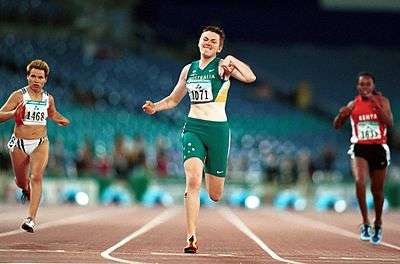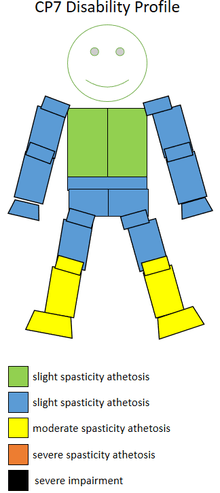T37 (classification)

T37 is a disability sport classification for disability athletics in track and jump events. It includes people who have coordination impairments such as hypertonia, ataxia and athetosis. It is the athletics equivalent of the more general CP7 classification.
Definition
This classification is for disability athletics in track and jump events.[1] This classification is one of seven classifications for athletes with cerebral palsy. Similar classifications are T32, T33, T34, T35, T36, and T38.[2] The Australian Paralympic Committee defines this classification as being for "Moderate to minimal hemiplegia (i.e. one half of the body affected – arm and leg on same side). Good functional ability in non affected side. Walks / runs without assistive devices, but with a limp." [3] The International Paralympic Committee defined this classification on their website in July 2016 as, "Coordination impairments (hypertonia, ataxia and athetosis)".[4]
Disability groups
Multiple types of disabilities are eligible to compete in this class. This class includes people who have have cerebral palsy, or who have had a stroke or traumatic brain injury.[5][6]
Cerebral palsy
CP7

Their running form manifests as if they have a limp.[6][7] Their disability manifests itself less when they are running as opposed to walking.[7] CP7 sportspeople are able to walk, but appear to do so while having a limp as one side of their body is more effected than the other.[6][7][8][9] They may have involuntary muscles spasms on one side of their body.[7][9] They have fine motor control on their dominant side of the body, which can present as asymmetry when they are in motion.[9][10] People in this class tend to have energy expenditure similar to people without cerebral palsy.[5]
Rules and performance
Athletes in this class are not required to use a starting block. It is up to the individual. They have the option to start from a crouch, from a standing position or 3 point stance.[11] Because of their disability, athletes may make movements that normally would disqualify them as a false start. If an official believes movement could be a result of this, they can restart the entire field without disqualifying any runners.[11]
Events
There are a number of track and field events open to this class at various international competitions. Many have their own minimum qualifying times and scores.
| gender | Event | Class | AQS/MQS | BQS | Event |
| men's | 100m | T37 | 11.6 | 11.79 | 2016 Summer Paralympics[12] |
| women's | 100m | T37 | 13.83 | 14.28 | 2016 Summer Paralympics |
| men's | 400m | T37 | 52.78 | 54 | 2016 Summer Paralympics |
| women's | 400m | T37 | 65.75 | 69.33 | 2016 Summer Paralympics |
| men's | 1500m | T37 | 04:18.7 | 04:30.0 | 2016 Summer Paralympics |
| men's | long jump | T37 | 6.16 | 5.78 | 2016 Summer Paralympics |
| women's | long jump | T37 | 4.5 | 4.08 | 2016 Summer Paralympics |
History
The classification was created by the International Paralympic Committee and has roots in a 2003 attempt to address "the overall objective to support and co-ordinate the ongoing development of accurate, reliable, consistent and credible sport focused classification systems and their implementation."[13]
Governance
Classification into this class is handled by the International Paralympic Committee.[4] For national events, classification is handled by the national athletics organization.[14]
Becoming classified
Athletes with cerebral palsy or similar impairments who wish to compete in para-athletics competition must first undergo a classification assessment. During this, they both undergo a bench test of muscle coordination and demonstrate their skills in athletics, such as running or jumping. A determination is then made as to what classification an athlete should compete in. Classifications may be Confirmed or Review status. For athletes who do not have access to a full classification panel, Provisional classification is available; this is a temporary Review classification, considered an indication of class only, and generally used only in lower levels of competition.[15]
References
- ↑ Buckley, Jane (2011). "Understanding Classification: A Guide to the Classification Systems used in Paralympic Sports". Archived from the original on April 11, 2011. Retrieved 12 November 2011.
- ↑ "Summer Sports » Athletics". Australia: Australian Paralympic Committee. Retrieved 19 November 2011.
- ↑ "Classification Information Sheet" (PDF). Sydney, Australia. 16 November 2011. Retrieved 19 November 2011.
- 1 2 "IPC Athletics Classification & Categories". www.paralympic.org. Retrieved 2016-07-22.
- 1 2 Broad, Elizabeth (2014-02-06). Sports Nutrition for Paralympic Athletes. CRC Press. ISBN 9781466507562.
- 1 2 3 "CLASSIFICATION SYSTEM FOR STUDENTS WITH A DISABILITY". Queensland Sport. Queensland Sport. Retrieved July 23, 2016.
- 1 2 3 4 "Kategorie postižení handicapovaných sportovců". Tyden (in Czech). September 12, 2008. Retrieved July 23, 2016.
- ↑ "Classification Made Easy" (PDF). Sportability British Columbia. Sportability British Columbia. July 2011. Retrieved July 23, 2016.
- 1 2 3 "Clasificaciones de Ciclismo" (PDF). Comisión Nacional de Cultura Física y Deporte (in Spanish). Mexico: Comisión Nacional de Cultura Física y Deporte. Retrieved July 23, 2016.
- ↑ Cashman, Richmard; Darcy, Simon (2008-01-01). Benchmark Games. Benchmark Games. ISBN 9781876718053.
- 1 2 "PARALYMPIC TRACK & FIELD: Officials Training" (PDF). USOC. United States Olympic Committee. December 11, 2013. Retrieved August 6, 2016.
- ↑ "ATHLETICS: RIO QUALIFICATION" (PDF). International Paralympic Committee. International Paralympic Committee.
- ↑ "Paralympic Classification Today". International Paralympic Committee. 22 April 2010. p. 3.
- ↑ "Athletics Classification". Australian Paralympic Committee. Australian Paralympic Committee. Retrieved August 6, 2016.
- ↑ "CLASSIFICATION Information for Athletes" (PDF). Sydney Australia: Australian Paralympic Committee. 2 July 2010. Retrieved 19 November 2011.
.svg.png)
.svg.png)
